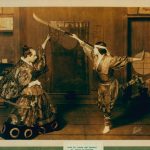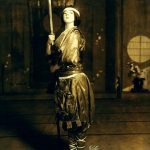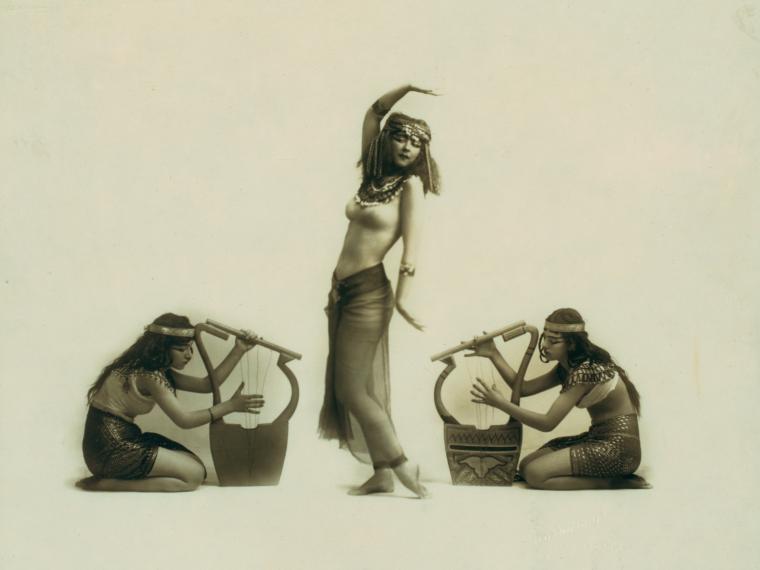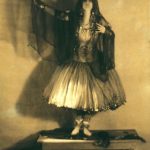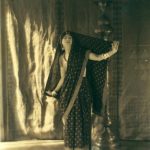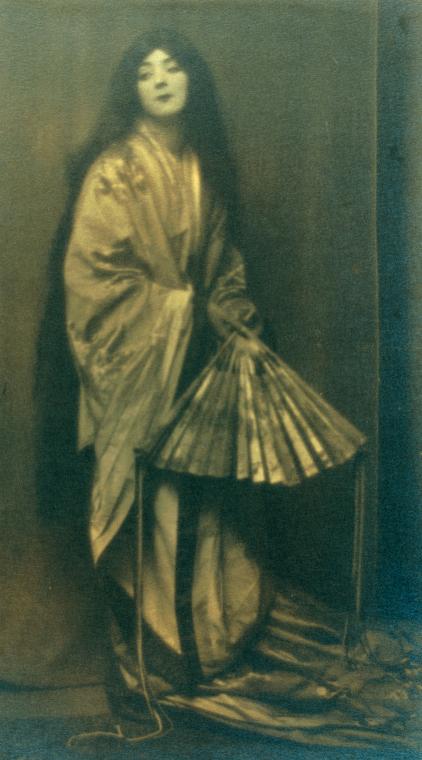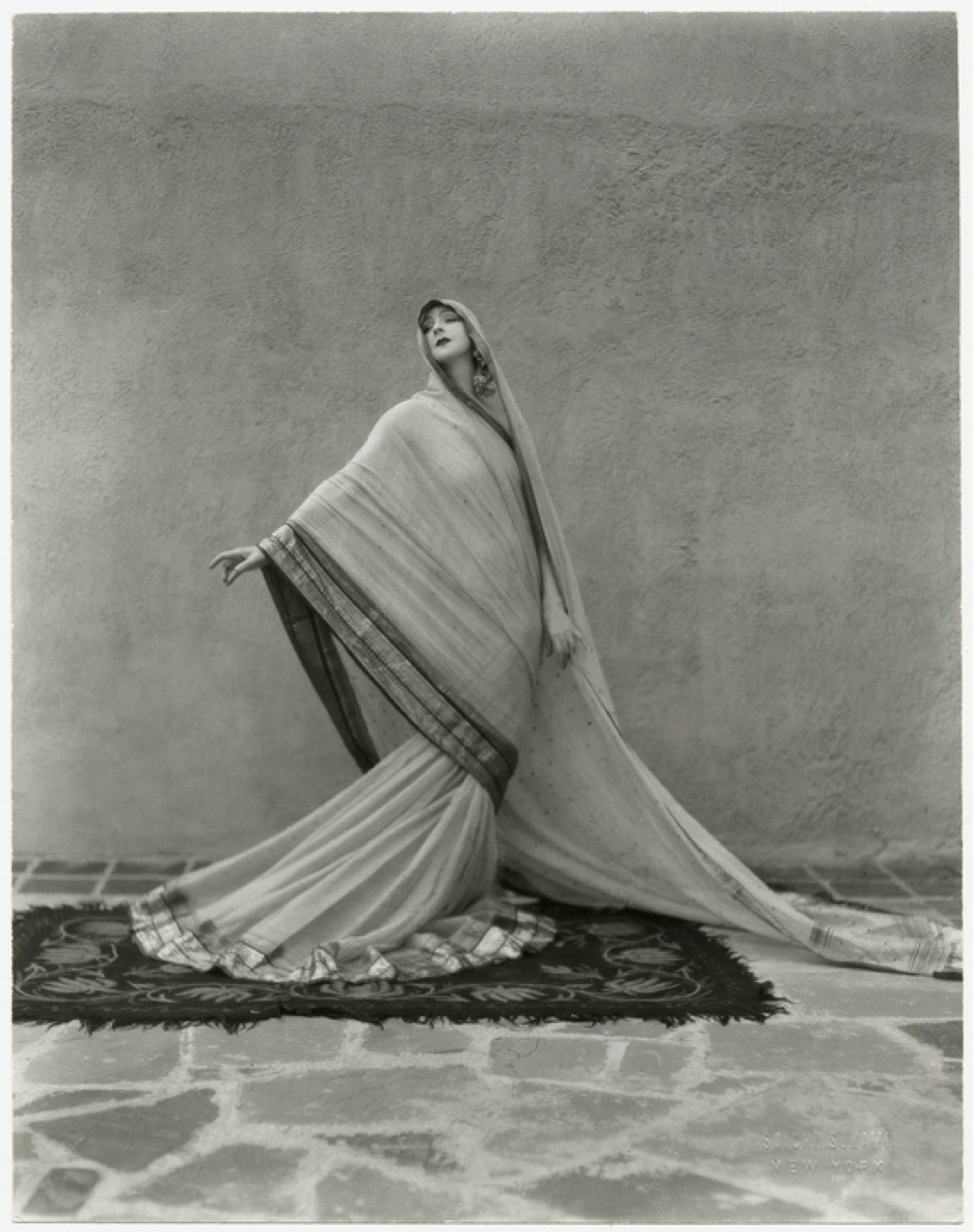Ruth St. Denis (Newark 1879 – Los Angeles 1968), nome d’arte di Ruthie Dennis, fu una danzatrice statunitense e cofondatrice della scuola Danishawan, una delle prime scuole di danza moderna in America. Fin da piccola fu introdotta al mondo dell’arte dai genitori, il padre inventore e la madre, una tra le prime donne laureate in medicina, si conobbero in una comunità artistica e tramandarono a Ruth l’idea del profondo legame tra danza e spiritualità. È proprio la madre, Ruth Emma Hull, a darle le prime lezioni di movimento ispirate alle teorie di François Delsarte.
Nel 1893 si trasferì a New York dove studiò con Ernesta Bossi e Maria Bonifanti e nel 1900 entrò nella compagnia di David Belasco con la quale andò in tournée in Europa. Affascinata dall’esotismo di inizio secolo e ispirata dalla dea Iside ritratta su una pubblicità di sigarette, cominciò a studiare le culture orientali. Nel 1905 lasciò la compagnia di Belasco per ideare le sue proprie creazioni. La più conosciuta, Radha, debuttò nel 1916, cinque anni dopo aver conosciuto Ted Shawn, danzatore e suo futuro marito, con il quale fondò nel 1915 la Ruth St. Denis School of Dancing and Its Related Arts, poi Denishawn School. Tra i tanti, vi studiarono Martha Graham, Doris Humphrey, Charles Weidman. Sempre nel 1916 partecipò al film di David Wark Griffith Intolerance e negli anni seguenti portò la sua compagnia in tournée sia in America che in Asia, dove oltre a esibirsi, approfondì lo studio delle diverse culture alle quali si ispirava. Dopo aver fondato nel 1928 una sede della scuola a New York, continuò a dedicarsi alla diffusione della sua idea di teatro sacro e alla promozione della danza all’interno delle religioni.
Pubblicò una raccolta di poesie, Lotus Light (1932), e nel 1939 l’autobiografia An Unfinished Life. Dopo la chiusura della Danishawn nel 1930 continuò a danzare e insegnare in autonomia, fondò l’Adelphi Univesity’s Dance Program nel 1938, primo corso universitario di danza, e nel 1940 aprì la School of Nataya, scuola interamente dedicata alle danze orientali. Danzò per l’ultima volta nel 1966, all’età di ottantasette anni, in Incense, uno dei suoi assoli più rappresentativi.
I suoi materiali sono conservati in diversi fondi d’archivio americani: l’University Archives and Special Collections della Adelphi University (Garden City, NY); la Library Special Collections alla UCLA Library; la New York Public Library. [Elisa Pescitelli]
Fonti e Bibl.: Ted Shawn, Ruth St. Denis: pioneer & prophet; being a history of her cycle of oriental dances, Printed for J. Howell by J. H. Nash, San Francisco 1920; Ruth St. Denis, The Dance of the East, «Theatre Arts Monthly. The International Magazine of Theatre and Screen», august, 1927; Ruth St. Denis, Lotus Light. Poem, Boston/New York 1932; Ruth St. Denis, An Unfinished Life, Harper & Brothers, New York/London 1939; Ruth St. Denis, My Vision, «Dance Observer», vol. 7, no. 3, 1940; Ruth St. Denis, Seeds of a New Order, in Division of Higher Education of the Board of Education of the United Methodist Church, «Motive», vol. 8, no. 7, 1948; Ruth St. Denis, What is Religious Dance?, «Dance Observer», vol. 17, no. 5, 1950; Ruth St. Denis, Freedom. A Rhythmic Interpretation, «Dance Observer», vol. 23, no. 1, 1956; Walter Terry, The Legacy of Isadora Duncan and Ruth St. Denis, «Dance Perspectives Foundation Inc», 1959; Ruth St. Denis, Religious Manifestations in the Dance, in Walter Sorell, The Dance has many Faces, Columbia University Press, New York/London 1968; Christena L. Schlundt, The Professional Appearances of Ruth St. Denis and Ted Shawn. A Chronology and an Index of Dances 1906-1932, Literary Licensing (LLC), New York 1962; Walter Terry, Miss Ruth: the “more living life” of Ruth St. Denis, Dodd, Mead & Co., New York 1969; Christena L. Schlundt, Into the mystic with Miss Ruth, «Dance Perspectives Foundation Inc», 1971; Ruth St. Denis, The Dance as Life Experience, in Jean Morrison Brown, The Vision of Modern Dance, Princeton Book Company, Princeton/New Jersey 1979; Ruth St. Denis, Dance as spiritual expression, in Frederick Rand Rogers, Dance: A Basic Educational Technique. A Functional Approach to the Use of Rhythmics and Dance as Prime Methods of Body Development and Control, and Transformation of Moral and Social Behaviour, Dance Horizons Inc., New York 1980; Suzanne Shelton, Divine Dancer: A Biography of Ruth St. Denis, Doubleday, New York 1981; Jane Sherman, Denishawn: The Enduring Influence, Twayne Publishers, Boston 1983; Jane Sherman, Christena L. Schlundt, Who’s St. Denis? What Is She?, «Dance Chronicle. Studies in Dance and the Related Arts», vol. 10, no. 3, 1987; Neil Douglas-Klotz, Ruth St Denis: Sacred Dance Explorations in America in Diane Apostolos-Cappadona, Douglas Adams, Dance as Religious Studies, Doug Adams & Diane Apostolos-Cappadona, New York 1990; Kamae A. Miller, Wisdom Comes Dancing: Selected Writings of Ruth St. Denis on Dance, Spirituality and the Body, PeaceWorks, Seattle 1997; Ruth St. Denis, Ballet of the States, «Dance Chronicle. Studies in Dance and the Related Arts», vol. 20, no. 1, 1997; Kimerer L. LaMothe, Passionate Madonna: The Christian Turn of American Dancer Ruth St. Denis, «Journal of the American Academy of Religion», vol. 66, no. 4, 1998; Jane Desmond, Dancing Out the Difference: Cultural Imperialism and Ruth St. Denis’s Radha of 1906, in Ann Dils, Ann Cooper Albright, Moving History, Dancing Cultures. A Dance History Reader, Wesleyan University Press, Wesleyan 2001; Vito Di Bernardi, Ruth St. Denis, L’Épos, Palermo 2006.











